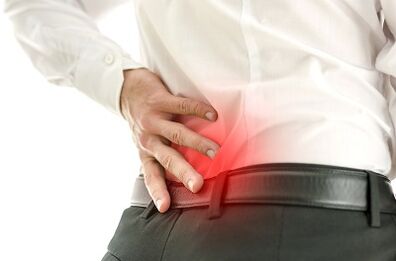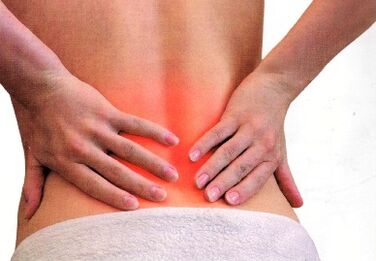Lumbar pain is one of the most common causes forcing a patient to seek help from a neurologist or therapist. Pain in the lumbosacral spine can be permanently inactivating, making movement and self-care impossible. Acute low back pain affects both men and women equally often.
Low back pain is more common in adolescents and young adults. This is due to rapid growth, weakness in the fragile muscles of the lower back, injuries. Thus, pain in the lumbosacral spine is the most pressing problem that anyone can face.

Low back pain with lumbar osteochondrosis
Lower back pain with osteochondrosis can increase with coughing and sneezing, with any movement, especially when the body leans forward. Along with back pain, lumbar osteochondrosis can manifest itself as a violation of the sensitivity of certain areas of the skin or muscles of the lower half of the trunk and legs, weakening or disappearance of the tendon reflexes of the legs.
- As a rule, in osteochondrosis there is a curvature of the lumbar spine. Depending on the plane in which the curvature occurs, a distinction is made between scoliosis (curvature to the right or left), lordosis (curvature forward) and kyphosis (smoothing of the lumbar spine or even its curvature backwards). In the case of osteochondrosis, the spinal cord is compressed, there is a violation of urination or defecation, as well as a violation of the sensitivity of the bladder or genitals.
- Most often, however, lumbar osteochondrosis is manifested by radicular pain - ie, developing as a result of pinching the nerve roots extending from the spinal cord to one level or another. So, one of the well-known lumbar syndromes is lumbago. This happens at the moment of physical stress or in an awkward position of the body, and sometimes for no apparent reason. Suddenly, within minutes or hours, a sharp shooting pain ("lumbago") occurs, often burning and spraying ("as if a stake were stuck in the lower back").
The patient freezes in an awkward position, unable to stand up if an attack occurs during weight lifting. Attempts to get out of bed, cough or bend the leg are accompanied by a sharp increase in pain in the lower back and sacrum. If the patient is asked to stand on his feet, then a sharp immobilization of the entire lumbar region due to muscle tension is revealed.
Tests for lumbosacral osteochondrosis
These tests are used as a way to conduct a preliminary diagnosis, they are named after the doctors who offered them.
| Dejerine's symptom | if you tighten your abdomen and listen to your lower back, the pain will become stronger. In this case, the patient is more likely to have osteochondrosis. |
| Neri's symptom | if, when the head is tilted sharply forward before touching the chest, there is pain in the lower back, this also indicates problems with the spine. |
| Lasegue symptom | this can be felt after the following actions: lying on your back, you need to lift each leg in turn. If then the lower back is distorted and the pain will be transmitted along the sciatic nerve to the leg, this is evidence of pathology of the spine. |
| Larry's symptom | if pain occurs in a person along the sciatic nerve, after he rises forward without bending his knees from a lying position, we are talking about manifestations of chondrosis. |
Disc herniation
Disc herniation is an equally rare cause, the clinical manifestation of which is lumbosacral back pain. The intervertebral disc (internal nucleus pulposus) with prolonged traumatic exposure, as well as with age, loses its elastic properties and elastic capacity.
With prolonged exposure (overweight, trauma, progressive osteoporosis), annular fibrosis of the disc thins and defects form in it. Through these weak spots in the fibrous ring, the nucleus of the pulp of the disc can shift and even protrude.
Causes of back pain
Back pain is such a non-specific symptom that it can be caused by many different reasons. From how much the back hurts in the lumbar region, whether it is permanent or periodic, primary or secondary, there may be reasons that cause it:
Chronic pain:
- Osteomyelitis;
- Ankylosing spondylitis;
- Deformed spondylosis;
- Growth diseases - scoliosis;
- Infectious lesions of the intervertebral discs and vertebrae (epidural abscess, spinal tuberculosis, brucellosis);
- Metabolic bone diseases - osteomalacia, osteoporosis;
- Primary tumors and metastatic tumors of the spinal cord, vertebrae, retroperitoneal space;
- Non-infectious inflammatory diseases - rheumatoid arthritis, Reiter's syndrome, ankylosing spondylitis;
- Kidney tumors;
- Atherosclerosis of the abdominal aorta and its branches.
Sharp pain:
- Spondyloarthritis;
- Pathology of the hip joint;
- Spinal epiduritis;
- Protrusion of intervertebral discs in the lumbar region;
- Osteochondritis of the spine;
- Acute intervertebral hernia;
- Intestinal obstruction, atypical course of acute appendicitis;
- Urolithiasis disease;
- Acute sprains, vertebral fractures;
- Lumbago, sciatica;
- Acute disorders of spinal circulation - stroke;
- Acute pyelonephritis.
Irradiation pain in some diseases of the internal organs:
- Diseases of the pelvic organs. In women - inflammatory processes in the uterine appendages, endometriosis, uterine cancer, ovarian cancer, sexually transmitted diseases (chlamydia, ureaplasmosis, gonorrhea, trichomoniasis, etc. ). In men - prostatitis, prostate cancer;
- Diseases of the stomach, pancreas, duodenum, gallbladder;
- Intestinal diseases - inflammation of the diverticulum, ulcerative colitis, intestinal tumors;
- Kidney disease - renal colic, kidney stones;
- Aortic dissection aneurysm.

Physiological causes
Low back pain can occur if:
- Are overweight;
- Additional risk for women;
- You are pregnant or have recently given birth;
- Spend a lot of time driving a car or computer;
- Lead a mostly sedentary (office workers) or upright (salespeople, waiters, street signatories, surgeons) lifestyle;
- Do dynamic physical work with a sharp change in body position (especially if your specialty is associated with heavy physical activity);
- Overload in the gym or fitness club. Be extremely careful if you have started training recently;
- They like to work in the summer villa;
- They have reached postmenopause, which favors the development of osteoporosis.
Low back pain and pregnancy
Pregnancy exacerbates the manifestations of diseases that exist in the mother's body. Due to changes in hormone levels and increased stress, pathologies occur especially often in the second half of pregnancy. In addition to the pain that accompanies the threat of premature birth, the cause of lower back pain in a pregnant woman can be:
- disc herniation;
- radiculitis;
- Pancreatitis;
- pyelonephritis;
- urolithiasis (kidney stones).
Why the back hurts below the lower back
When the back hurts below the lumbar region, in addition to obvious diseases of the spine (sciatica, lumbago, intervertebral hernias, ankylosing spondylitis, etc. ), possible causes are periodic menstrual pain in women, diseases of the female genital organs, such as. inflammation of the uterine appendages - oophoritis, salpingo-oophoritis (adnexitis), as well as diseases of the pelvic peritoneum, intestines, inflammation of the appendix (appendix of the appendix), in men - diseases of the prostate gland, bladder.
Pain over the lower back
If the back hurts to the right above the lower back - so the liver pain can radiate, with any pathological changes in the liver - hepatitis, liver failure, taking toxic drugs. The pain in this case is most often localized in the right hypochondrium.
If the pain is felt on the right or left just above the lower back, it is very possible that the cause lies in acute kidney disease. Many chronic kidney diseases such as polycystosis, malignant neoplasms of the kidneys, chronic pyelonephritis are accompanied by minor symptoms, as the renal capsule gradually stretches.
When should you see a doctor?
- If the back pain radiates to the lower back, and it itself is located a little higher (in the chest area). The pain is accompanied by sweating, vomiting and nausea, shortness of breath.
- The pain radiates to the peritoneum, chest, neck, jaw.
- The patient is dizzy and confused.
- Tachycardia begins.
- Spinal cord injury accompanied by loss of control over defecation, urination.
- Legs weaken, buttocks, genitals tingle.

Diagnosis
To determine which disease has provoked lower back pain, it is necessary to undergo a comprehensive diagnostic examination.
Laboratory methods:
- General and biochemical analyzes of urine and blood.
- Tests for the presence of tumor markers in the blood during tumor formation.
Instrumental research methods:
- X-ray of the spine.
- Endoscopy of the intestine, stomach and uterus.
- Ultrasound examination of the abdominal cavity.
- Magnetic resonance.
How to treat low back pain?
How to properly treat the lower back? The approach to treating the back depends entirely on the symptoms of the disease, the diagnosis made by the doctor, and the stage of the disease. An integrated approach is usually used, which includes several methods of treatment.
Pain medications. . .The ointment helps relieve inflammation, stretch and has a warming effect if the lower back has a cold.
The following groups of ointments are distinguished:
- combined drugs (used for sprains and injuries, along with anti-inflammatory and analgesic effects, they have a healing effect due to their constituent substances);
- anti-inflammatory analgesics (they contain medicinal substances with a cooling effect that relieve irritation - menthol, lavender and painkillers);
- chondroprotectors (one of the active components of such drugs is a substance used in pathological processes in cartilage tissue, which contributes to the active restoration of the cartilaginous surfaces of the joints);
- irritating drugs (the effect is based on vasodilation and blood flow to the source of pain).
With the help of therapeutic exercises the patient will be able to reduce the pain, make the muscles strong, increasing the distance between the vertebrae. They will help release compressed nerve roots, normalize blood flow to the affected area and improve metabolic processes.
In order for such gymnastics to heal and not to cripple, all the recommendations of the attending physician must be followed.
- The movements are performed slowly and smoothly, without sharp turns;
- Before training, the room should be ventilated;
- The patient should wear clothing that does not restrict movement;
- The exercise is performed when the patient inhales and when exhaling he must return to the original position;
- The load increases gradually. First, the number of approaches is about 10, and then they increase;
- You need to monitor your well-being during gymnastics. If acute pain begins, then you should stop training.
In addition, massage is excellent for relieving pain in the lumbar spine. The positive therapeutic effects of massage include the following:
- improving the blood supply to the diseased part of the body;
- kneading the muscles, which makes them and the ligaments more flexible and elastic;
- relief of acute pain;
- getting rid of toxins accumulated in the muscles and subcutaneous tissue;
- pleasant sensations due to stimulation of the nerve endings of the skin;
- positive emotions.
It can be entrusted to a specialist in the clinic or conducted at home, in any case the benefits will be invaluable.
Which doctor should I go to?
For back pain, the cause of which is unknown, the first step is to visit a therapist. This will help determine the disease through a combination of symptoms.
If the cause is obvious: the pain is preceded by an injury, the pain arose against the background of pregnancy, menstruation or chronic illness, it makes sense to immediately contact a narrower specialist.
Self-medication is permissible only in cases where the exact cause of the pain is known.
















